What Is the Bullwhip Effect in Supply Chain Management?
The bullwhip effect refers to the distortion of demand and an increase in volatility that takes place when orders and forecasts move from the retailer to the manufacturer. In the event of a surge in demand, each participant in the supply chain places additional product orders as a safeguard. While this practice is necessary to guarantee product, it results in inaccurate forecasting, hoarding of inventory, inefficiencies from overstocking, and eventual product shortages if adopted by all supply chain.
To illustrate the bullwhip effect, let's take the example of a retailer who sells personal heaters. During winter, their sales spike to 15 units a day from an average of five units a day. To meet this demand, the retailer orders 20 units from their wholesaler, who in turn orders 30 units from the manufacturer. The manufacturer then increases their production to 40 units.
Thus, a surge in demand for 15 units a day has ballooned to 40 units, many of which won't reach the retailer until after the demand spike is over. However, if an early Spring appears while the products are being made, the retailer's forecasts and subsequent orders will be affected.
The bullwhip effect can also be compounded by hoarding stock. Buyers may place large orders upstream to buffer their inventory and stay ahead of low stock issues, even with only a slight change in demand. As demand moves up the chain, inventory becomes less predictable, resulting in overstock and low stock periods, and supply chain unpredictability.

What is the bullwhip effect in supply chain?
How the Bullwhip Effect Impacts the Supply Chain
The bullwhip effect has a significant impact on supply chain management, resulting in the following consequences:
- Holding excess inventory is increased storage costs , including the expenses for physical storage space, the inefficiencies of storing items with low demand, and the cost of transportation and selling. In addition, the bullwhip effect makes storage and shipping costs less predictable.
- Increased labor costs: Extra employees are required to handle, sort, and sell excess inventory. Furthermore, if a seller runs out of stock, salespeople may have to work harder to find alternatives or arrange for delivery later, resulting in higher labor costs.
- Unmet customer expectations: Products shortages can damage a company's reputation and profits. Inability to fulfill customer demands can frustrate customers, cause them to perceive the company as unreliable, and prompt them to seek alternative brands or partners.
- Waste: Excessive inventory can lead to costly waste, depending on the type of product. For example, perishable items like food or pharmaceuticals can expire before they can be sold, and other products may be withdrawn from the market or replaced by newer versions. These events can reduce the items' value, increase the resources required to sell them, or result in the cost of disposal.

How the Bullwhip Effect Impacts the Supply Chain
How to Control the Bullwhip Effect
Minimizing the bullwhip effect is critical for predicting predictable and profitable supply chain management. While the bullwhip effect can have a range of impacts, there are several solutions to address it. Here are some tips on how to reduce the bullwhip effect:
- Increase Transparency Between Suppliers and Customers
Improving visibility across the chain can help everyone see the context of demand changes.
Tools such as Electronic Data Interchange (EDI), Vendor Managed Inventory (VMI), Internet of Things (IoT), and Supplier Enablement portals can be used to enhance transparency.
- Start Predicting
Smart predictions are key to better understanding demand changes.
Predictive analytics can be used to interpret historical trends and generate forecasts of future trends, improve demand, determine ideal inventory levels and shipping methods, and significantly improve inventory management.
- Encourage Collaboration Between Partners
Collaboration between different members of the supply chain is essential to avoid the bullwhip effect.
Shared information and real-time data are essential to strategic collaboration, improving forecast accuracy, strengthening relationships, and preventing disruptions before they occur.
Vendor Managed Inventory (VMI) and aligning key performance indicators (KPIs) can help facilitate collaboration.
- Reduce Lead Times
Long lead times can excule the bullwhip effect, resulting in overstock.
Strategies to shorten lead times include using trusted, local suppliers, investing in VMI, hiring a logistics manager, reevaluating shipping methods, and automating manufacturing.
- Minimize or Address Price Fluctuations
Frequent promotions or discounts can disrupt typical buying patterns and cause more interruptions than benefits.
Consider minimizing or incorporating promotions more accurately into predictions and forecasts.

How to Control the Bullwhip Effect
By understanding and controlling the bullwhip effect in supply chain , companies can achieve predictable profitable and supply chain management.












Replies to This Discussion